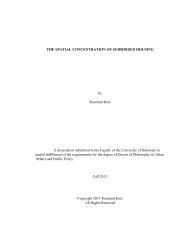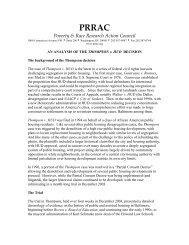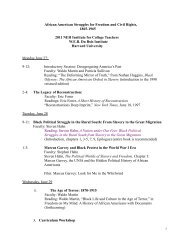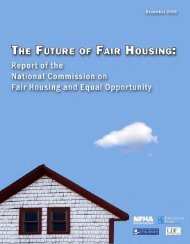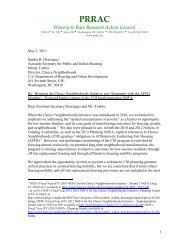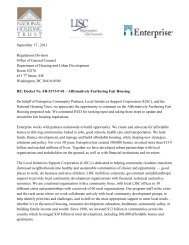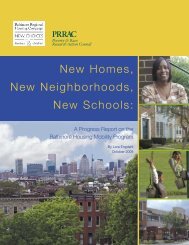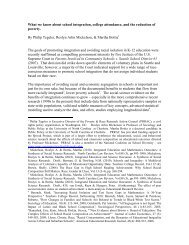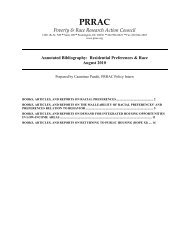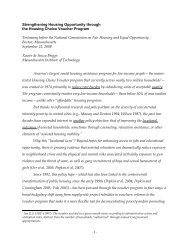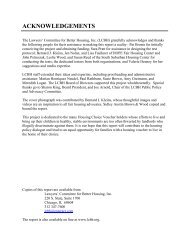Annotated Bibliography of Housing Mobility Research 2006-2010
Annotated Bibliography of Housing Mobility Research 2006-2010
Annotated Bibliography of Housing Mobility Research 2006-2010
Create successful ePaper yourself
Turn your PDF publications into a flip-book with our unique Google optimized e-Paper software.
egional voucher program operating with deliberate attention to expanding fair housing choice by<br />
targeting vouchers to lowpoverty neighborhoods with less than 30% minority population and less<br />
than 5% public housing or HUDassisted complexes. Describes the key features for program<br />
success, including financial education, bus tours <strong>of</strong> highopportunity neighborhoods, twoplus<br />
years <strong>of</strong> postmove counseling and secondmove counseling, employment and transportation<br />
assistance, and monitoring. Almost 90% <strong>of</strong> families moved to suburban counties and families<br />
consistently report high levels <strong>of</strong> satisfaction with their new neighborhoods and homes, including<br />
satisfaction with new schools, with high rates <strong>of</strong> retention (62% stayed in their initial unit).<br />
Ferryman, Kadija, Xavier de Souza Briggs, Susan J. Popkin & Maria Rendon, “Do Better<br />
Neighborhoods for MTO Families Mean Better Schools”, The Urban Institute (2008)<br />
Abstract:<br />
One expected benefit <strong>of</strong> moving poor families from the concentrated poverty <strong>of</strong> some inner city<br />
neighborhoods to better, less poor neighborhoods, was that the children would attend better<br />
schools, with more resources and more advantaged peers who might be models for hard work and<br />
higher achievement. This brief looks at the schools MTO children attended after their move, how<br />
they did or did not differ from the schools in their premove neighborhoods, and what factors<br />
mattered to families choosing schools for their children.<br />
Frey, William, “Diversity Spreads Out: Metropolitan Shifts in Asian, Black, and Hispanic<br />
Populations Since 2000,” Living Cities Census Series, Brookings Institution (<strong>2006</strong>)<br />
Summary: Analysis <strong>of</strong> Census Bureau population estimates detailing the distribution <strong>of</strong> racial and ethnic<br />
groups within and across U.S. metropolitan areas since Census 2000 reveals that: Hispanic and<br />
Asian populations are spreading out from their traditional metropolitan centers, while the shift <strong>of</strong><br />
blacks toward the South is accelerating; the fastest growing metro areas for each minority group in<br />
2000–2004 are no longer unique, but closely parallel the fastest growing areas in the nation; <strong>of</strong> the<br />
nation's 361 metropolitan areas, 111 registered declines in white population from 2000 to 2004,<br />
with the largest absolute losses occurring in New York, San Francisco, and Los Angeles;<br />
minorities contributed the majority <strong>of</strong> population gains in the nation's fastestgrowing metropolitan<br />
areas and central metropolitan counties from 2000 to 2004; a strong multiminority presence<br />
characterizes 18 large "melting pot" metro areas, and 27 large metro areas now have "majority<br />
minority" child populations. Hispanic, Asian, and black populations continue to migrate to, and<br />
expand their presence in, new destinations. They are increasingly living in suburbs, in rapidly<br />
growing job centers in the South and West, and in more affordable areas adjacent to higherpriced<br />
coastal metro areas. The wider dispersal <strong>of</strong> minority populations signifies the broadening<br />
relevance <strong>of</strong> policies aimed at more diverse, including immigrant, communities.<br />
Galvez, Martha M., “Finding housing with a Section 8/<strong>Housing</strong> Choice Voucher in Seattle,”<br />
Paper draft, NYU Furman Ctr. for Real Estate & Urban Policy (April <strong>2010</strong>)<br />
Highlights:<br />
Abstract:<br />
· 40% <strong>of</strong> voucher holders lived in the same five neighborhoods; half <strong>of</strong> voucher holders would<br />
need to move to achieve an even distribution<br />
· Recommends use <strong>of</strong> portable screening reports to help voucher holders find willing landlords,<br />
as well as direct financial assistance to help alleviate burden <strong>of</strong> housing search costs<br />
· Suggests local source <strong>of</strong> income discrimination ordinance is not enough to prevent actual<br />
discrimination need statewide protections and stronger enforcement<br />
The goal <strong>of</strong> this project is to shed light on how Section 8/<strong>Housing</strong> Choice Voucher holders in<br />
Seattle experience the housing search process. Of particular interest are two obstacles commonly<br />
believed to limit housing options for voucher program participants: landlord discrimination against<br />
voucher holders; and high search costs. Data from interviews and focus groups with 31 successful<br />
Seattle <strong>Housing</strong> Authority (SHA) voucher participants suggest that both are significant challenges<br />
facing voucher holders searching for housing.<br />
10



